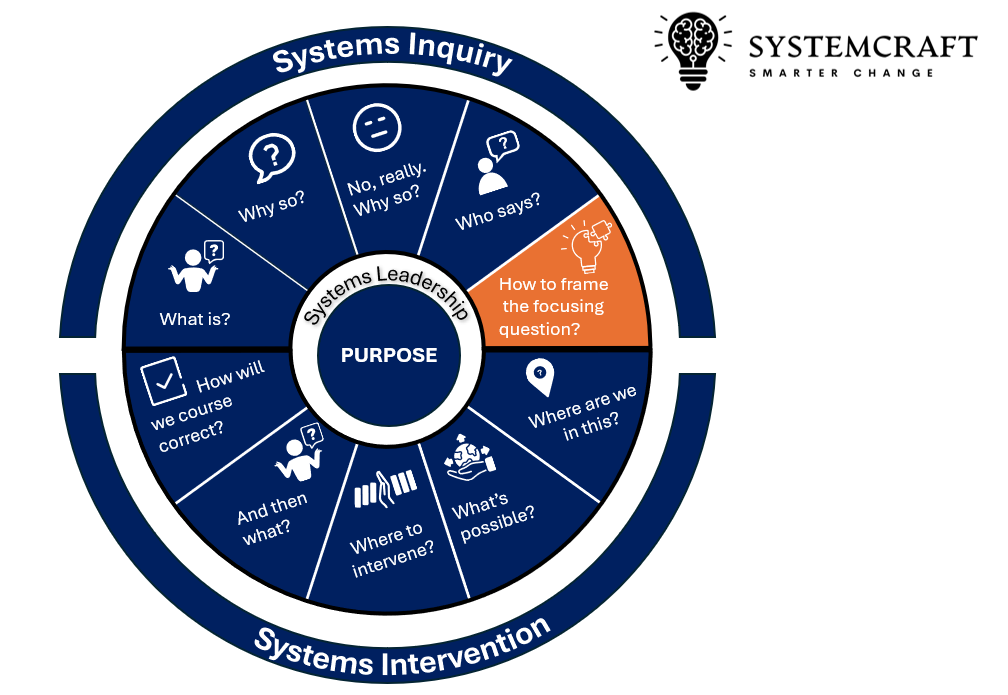11 How to frame the focussing question?
Figure 8. Systemscraft. How to frame the focusing question. (Joyner, 2025)
Crafting a question that recognises the different needs and interests of stakeholders, forming the link between the Inquiry and Intervention phases.
In systems thinking, particularly in the Systemcraft framework, one of the most critical steps in moving from inquiry to intervention is framing the focusing question. This step serves as a bridge, transforming a landscape of complexity, competing interests, and divergent worldviews into a unified starting point for action. Drawing on Peter Checkland’s (1990) Soft Systems Methodology, we recognise that stakeholders approach any problem with a mosaic of perspectives, different interests, worldviews, and preferred outcomes. The focusing question is a means of demonstrating to all in the system that their perspectives have been heard and that there can be a way forward, even as we acknowledge the reality of tensions and trade-offs.
Why Is Framing Important?
Complex problems rarely have a single, universally accepted definition. This is why in Systemcraft we use the idea of ‘framing the question’ rather than framing the problem. The act of defining a problem is itself an exercise of power and influence. Who gets to decide the problem’s framing can determine which voices are amplified, which solutions are considered legitimate, and which are sidelined. In this light, the focusing question must be developed with intentionality and inclusivity, reflecting an understanding of the dynamics and diversity within the system, and identifying the defining tensions that may require the stakeholders to make trade-offs.
Principles for Framing a Focusing Question
The question must incorporate the perspectives and concerns of all key stakeholders. This does not mean that every viewpoint will be satisfied but that the framing process acknowledges and respects the range of voices involved.
A focusing question should neither be too narrow—excluding important dimensions of the issue—nor too broad—making the problem seem intractable. The goal is to find a middle ground that provides direction without oversimplifying. The question should encourage consideration of interconnections, feedback loops, and unintended consequences. It should steer stakeholders toward thinking holistically rather than in silos. While grounded in the current state, the question should point toward a future that stakeholders can collectively envision and aspire to.
Techniques for Developing the Focusing Question: The Joint Framing Tool
- Start with Broad Questions: Begin by having each stakeholder articulate their perspective on the problem. Then, instead of focusing on disagreements, encourage everyone to explore why this issue matters to them. Ask “Why is this issue important to you?” or “What outcome are you trying to achieve? “
- Uncover Underlying Concerns: Use subsequent “Why?” questions to identify the fundamental concern or motivation behind each stakeholder’s perspective. This helps reveal the core interest, often showing areas of commonality or shared values.
- Synthesise Common Ground: Once you’ve distilled each stakeholder’s concern to its essence, look for overlaps. A shared or aligned interest can become the basis for the focusing question. The focusing question should seek to address a challenge or opportunity related to these shared concerns.
- Phrase the Question Openly: Encourage the group to frame the question in an open-ended way that invites exploration rather than a definitive answer. For instance: “How can we improve X without compromising Y?” or “What steps can we take to meet both needs A and B?”
Examples
Examples of Focusing Questions
- Healthcare Reform: “How might we design a healthcare system that improves access and equity while ensuring long-term sustainability?”
- Urban Development: “What strategies can enable inclusive growth in our city while preserving environmental resilience?”
- Workplace Culture: “How can we foster a culture that supports innovation, collaboration, and well-being in our organisation?”
Bridging to Action
The focusing question is not an endpoint but a gateway. It takes the messy, multifaceted reality of a complex problem and distils it into a form that stakeholders can coalesce around, paving the way for structured inquiry and intentional action. In Systemcraft, this step exemplifies the shift from merely understanding the system to actively engaging with it, a shift that requires both rigour and humility.
By crafting focusing questions with care and insight, we set the stage for meaningful interventions, rooted in a shared understanding and a commitment to learning as we go.
Key Takeaways
- Framing the Focusing Question as a Bridge Between Inquiry and Intervention
In systems thinking, particularly within the Systemcraft framework, the transition from understanding a complex problem to taking action hinges on framing a well-constructed focusing question. This question serves as a unifying starting point, acknowledging diverse stakeholder perspectives while narrowing the scope to an actionable domain. - The Power of Framing in Complex Systems
Defining a problem is inherently an exercise of power; it influences which perspectives are heard, which solutions are legitimised, and which remain overlooked. A well-framed focusing question must be inclusive, reflect system dynamics, and balance competing tensions while avoiding oversimplification. - A Structured Approach to Crafting Effective Questions
Developing a focusing question involves a structured approach: engaging stakeholders in broad discussions, uncovering underlying concerns through iterative “why” questions, identifying shared interests, and phrasing the question in an open-ended way to foster collaboration and action. A well-crafted question not only clarifies the issue but also facilitates meaningful intervention.
References
- Checkland, P., & Scholes, J. (1990). Soft systems methodology in action. Wiley
- Joyner, K. (2025) Systems thinking for leaders. A practical guide to engaging with complex problems. Queensland University of Technology. https://qut.pressbooks.pub/systemcraft-systems-thinking/


